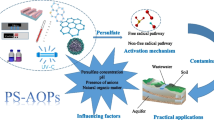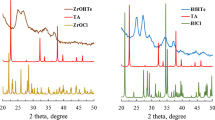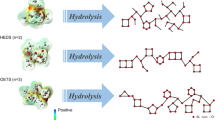Abstract
The thermal decomposition behaviors of 4,4′-azo-bis(1,2,4-triazolone) (ZTO) and its salts were investigated for the first time by using accelerating rate calorimetry. Based on the experimental results, the kinetic parameters of exothermic reaction of ZTO and its salts were calculated. The thermal decomposition parameters, including the initial decomposition temperature, the adiabatic temperature rise rate, were obtained from the thermal inertia factor. The adiabatic experiment revealed that ZTO and KZTO·H2O both had a relatively high initial exothermic decomposition temperature at 230.6 and 235.6 °C, respectively. The maximum self-heating rate of exothermic process of ZTO was 105.9 °C min−1 (at 248.7 °C), which meant that ZTO decomposed very fast. In addition, the reaction order, apparent activated energy (E a), and pre-exponential factor (A) were also calculated.



Similar content being viewed by others
Abbreviations
- Φ :
-
Thermal inertia factor
- T 0/°C:
-
Initial self-heat temperature
- T f/°C:
-
Final decomposition temperature
- ∆T ad/°C:
-
Adiabatic temperature rise
- m 0/°C min−1 :
-
Initial temperature rise rate
- m m/°C min−1 :
-
Maximum temperature rise rate
- T m/°C:
-
Temperature of maximum temperature rise rate
- θ m/min:
-
Time of maximum temperature rise rate
- E a/kJ mol−1 :
-
The apparent activation energy
- R :
-
The gas constant
- A :
-
Pre-exponential factor
- r :
-
Correlation coefficient
References
Gao HX, Shreeve JM. Azole-based energetic salts. Chem Rev. 2011;111(11):7377–436.
Zhang QH, Shreeve JM. Energetic ionic liquids as explosives and propellant fuels: a new journey of ionic liquid chemistry. Chem Rev. 2014;114(20):10527–74.
Dippold AA, Klapötke TM. A study of dinitro-bis-1,2,4-triazole-1,1′-diol and derivatives: design of high-performance insensitive energetic materials by the introduction of N-Oxides. J Am Chem Soc. 2013;135(26):9931–8.
Zhu JP, Jin SH, Wan L, Zhang CY, Li LJ, Chen SS, Shu QH. Nitrogen-rich 4,4′-azobis(1,2,4-triazolone) salts—the synthesis and promising properties of a new family of high-density insensitive materials. Dalton Trans. 2016;45:3590–8.
Ma C, Huang J, Ma HX, Xu KZ, Lv XQ, Song JR, Zhao NN, He JY, Zhao YS. Preparation, crystal structure, thermal decomposition, quantum chemical calculations on [K(ZTO)·H2O]∞ and its ligand ZTO. J Mole Struct. 2013;1036:521–7.
Zhu JP, Jin SH, Yu YH, Li LJ, Chen SS, Shu QH. The crystal structure and thermal analysis of ZTO and its solvent adducts. Res Chem Intermed. 2016;42(5):4333–40.
Zhu JP, Jin SH, Yu YH, Wan L, Li LJ, Chen SS, Shu QH. Preparation, crystal structure, thermal behavior, and theoretical studies of N,N′-dinitro-4,4′-azo-bis(1,2,4-triazolone) (DNZTO). Z Naturforsch. 2016;71(3b):197–204.
Zhu JP, Jin SH, Yu YH, Zhang CY, Li LLJ, Chen SS, Shu QH. Evaluation of thermal hazards and thermo-kinetic parameters of N,N’-dinitro-4,4′-azo-Bis(1,2,4-triazolone) (DNZTO). Thermochim Acta. 2016;623:58–64.
Zhong YT, Huang J, Song JR, Xu KZ, Zhao D, Wang LQ, Zhang XY. Synthesis, crystal structure and thermal behavior of GZTO·H2O. Chin J Chem. 2011;29(8):1672–6.
Iwata Y, Momota M, Koseki H. Thermal risk evaluation of organic peroxide by automatic pressure tracking adiabatic calorimeter. J Therm Anal Calorim. 2006;85:617–22.
Sridhar VP, Surianarayanan M, Sivapirakasam SP, Mandal AB. Adiabatic thermokinetics and process safety of pyrotechnic mixtures. J Therm Anal Calorim. 2012;109:1387–95.
Sivapirakasam SP, Mohamed NM, Surianarayanan M, Sridhar VP. Evaluation of thermal hazards and thermo-kinetic parameters of a matchhead composition by DSC and ARC. Thermochim Acta. 2013;557:13–9.
Zhang GY, Jin SH, Li LJ, Li YK, Wang DQ, Li W, Zhang T, Shu QH. Thermal hazard assessment of 4,10-dinitro-2,6,8, 12-tetraoxa-4,10-diazaisowutrzitane (TEX) by accelerating rate calorimeter (ARC). J Therm Anal Calorim. 2016;126:467–71.
Sivapirakasam SP, Surianarayanan M, Vijayaraghavan R. Thermal characterization and kinetic modeling of a pyrotechnic flash composition under adiabatic conditions. J Pyrotech. 2006;23:61–6.
Surianarayanan M, Sivapirakasam SP, Swaminathan G. Accident data analysis and hazard assessment in fireworks manufacture. Sci Technol Energ Mater. 2008;69(5):161–8.
Lv JY, Chen WH, Chen LP, Tian YT, Yan JJ. Thermal risk evaluation on decomposition processes for four organic peroxides. Thermochim Acta. 2014;589:11–8.
Yang T, Chen LP, Chen WH, Zhou YS, Gao HS, Zhong TT. Thermal stability of 2-ethylhexyl nitrate with acid. J Therm Anal Calorim. 2015;119:205–12.
Lu KT, Yang CC, Lin PC. The criteria of critical runaway and stable temperatures of catalytic decomposition of hydrogen peroxide in the presence of hydrochloric acid. J Hazard Mater. 2006;135:319–27.
Fu ZM, Koseki H, Iwata Y. Investigation on thermal stability of flavianic acid disodium salt. J Loss Prevent Proc. 2009;22:477–83.
Townsend DI, Tou JC. Thermal hazard evaluation by an accelerating rate calorimeter. Thermochim Acta. 1980;37:1–30.
Acknowledgements
The authors gratefully acknowledge the financial support by Natural Science Foundation of Guangdong (Grant Nos. 2014A030313559, 2016A030313050), the Nanshan District Key Lab for Biopolymers and Safety Evaluation (No. KC2014ZDZJ0001A), and the Science and Technology Project of Shenzhen City (Grant Nos. JCYJ20140828163633993, CYZZ20150827160341635, ZDSYS201507141105130, and JCYJ20170412105034748). We are indebted to Dr. Zhang Guangyuan who works in Gansu Yinguang Chem Ind Grp Co., Ltd., for considerable assistance with ARC testing.
Author information
Authors and Affiliations
Corresponding authors
Rights and permissions
About this article
Cite this article
Zhu, J., Jin, S., Cheng, B. et al. Thermal stability assessment of 4,4′-azo-bis(1,2,4-triazolone) (ZTO) and its salts by accelerating rate calorimeter (ARC). J Therm Anal Calorim 132, 563–569 (2018). https://doi.org/10.1007/s10973-017-6896-x
Received:
Accepted:
Published:
Issue Date:
DOI: https://doi.org/10.1007/s10973-017-6896-x




